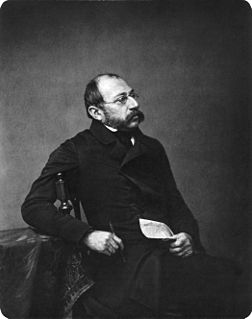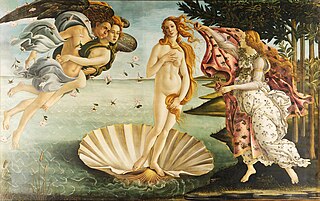
Carl Spitzweg was a German romanticist painter, especially of genre subjects. He is considered to be one of the most important artists of the Biedermeier era.
Das Erste is the flagship national television channel of the ARD association of public broadcasting corporations in Germany. ARD and ZDF – "the Second" German Television Channel – together comprise the public service television broadcasters in the German television system. Das Erste is jointly operated by the nine regional public broadcasting corporations that are members of the ARD.

Dieter Herbert Nuhr is a German comedian, cabaret artist, author and television presenter.

Tatort is a German language police procedural television series that has been running continuously since 1970 with some 30 feature-length episodes per year, which makes it the longest-running German TV drama. Developed by the German public-service broadcasting organisation ARD for their channel Das Erste, it is unique in its approach, in that it is jointly produced by all of the organisation's regional members as well as its partnering Austrian and Swiss national public-service broadcasters, whereby every regional station contributes a number of episodes to a common pool.
Television in Germany began in Berlin on 22 March 1935, broadcasting for 90 minutes three times a week. It was home to the first public television station in the world, named Fernsehsender Paul Nipkow. The German television market had approximately 36.5 million television households in 2000, making it the largest television market in Europe. Nowadays, 95% of German households have at least one television receiver. All the main German TV channels are free-to-air.

The Neue Pinakothek is an art museum in Munich, Germany. Its focus is European Art of the 18th and 19th centuries, and it is one of the most important museums of art of the nineteenth century in the world. Together with the Alte Pinakothek and the Pinakothek der Moderne, it is part of Munich's "Kunstareal".

Rundfunk Berlin-Brandenburg is an institution under public law for the German states of Berlin and Brandenburg, based in Berlin and Potsdam. RBB was established on 1 May 2003 through the merger of Sender Freies Berlin (SFB) and Ostdeutscher Rundfunk Brandenburg (ORB), based in Potsdam, and is a member of the Association of PSBs in the Federal Republic of Germany (ARD).

Ostdeutscher Rundfunk Brandenburg, based in Potsdam, was the public broadcaster for the German federal state of Brandenburg from 12 October 1991 until 30 April 2003. It was a member organization of the consortium of public-law broadcasting organizations in Germany, ARD.

Wilhelm Trübner was a German realist painter of the circle of Wilhelm Leibl.

100 Great Paintings is a British television series broadcast in 1980 on BBC 2, devised by Edwin Mullins. He chose 20 thematic groups, such as war, the Adoration, the language of colour, the hunt, and bathing, picking five paintings from each. The selection ranges from 12th-century China through the 1950s, with an emphasis on European paintings. He deliberately avoided especially famous paintings, such as Leonardo da Vinci's Mona Lisa or John Constable's The Haywain. The series is available on VHS and DVD.

Polizeiruf 110 is a long-running German-language detective television series likened to poirot. The name links to the emergency telephone number of the Volkspolizei. The first episode was broadcast 27 June 1971 in the German Democratic Republic (GDR), and after the dissolution of Deutscher Fernsehfunk the series was picked up by ARD. It was originally created as a counterpart to the West German series Tatort, and quickly became a public favorite.

The Bavarian State Painting Collections, based in Munich, Germany, oversees artwork held by the Free State of Bavaria. It was established in 1799 as Centralgemäldegaleriedirektion. Artwork includes paintings, sculptures, prints, photographs, video art and installation art. Pieces are on display in numerous galleries and museums throughout Bavaria.
Bayerischer Fernsehpreis is an award presented by the government of Bavaria, Germany since 1989.

Joseph Fassbender (Faßbender) was a German painter and draughtsman.
Diana Amft is a German film and television actress and children's writer. She is best known for playing Gretchen Haase in the RTL sitcom Doctor's Diary.

Neues vom Süderhof is a German children's television series. The heart of the series are the five Brendel children who live on the Süderhof farm. Dr. Günther Brendel is a veterinarian and his wife Sonia is an author writing a book about parenting. They live with their two daughters, Bimbo and Molle, and next door live Grandma and Grandpa Brendel. After Günther's brother and sister-in-law are killed in a plane crash, Sonia and Günther adopt their children, Dany, Peggy, and Benny. Thus, the series chronicles the experiences of these five children and their lives on the Süderhof farm.
Christian Lerch is a journalist and radio documentary producer based in Vienna, Austria and Berlin, Germany.
Rita Maria Walburga Grosse-Ruyken is a contemporary German artist, sculptor, multimedia installation art, artfilm and performance, producer artist and member of the Association of German Artists Deutscher Kuenstlerbund. The core of her light – sound – space – form installations comprise sculptures in motion made from pure gold and silver. She became internationally known through her exhibition Rays of Light.
Hannes Michael Schalle is an Austrian director, writer, producer and film composer.

Italia und Germania is an allegorical painting of the painter Friedrich Overbeck, finished in 1828. The painting shows two women inclining to each other, symbolizing the friendship between the two countries or cultures they represent: Italia and Germania. At that time, both Italy and Germany were cultural regions but not unified national states.












